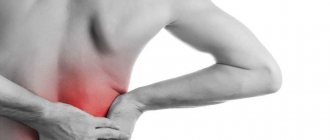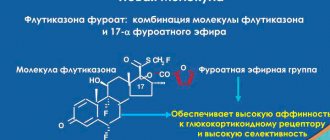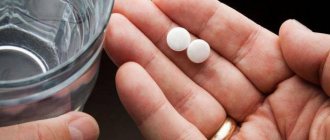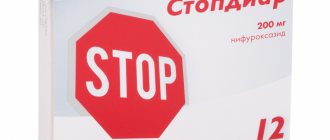Composition and release form
The medicine Gaviscon has 2 release forms: tablets and suspension for oral use.
Tablets with a chewable base, slightly flat with a round shape and a light shade. They have minor inclusions over the entire surface, with a pleasant smell of mint or lemon. Packaged in cardboard packaging with 2-4 blisters, each containing 8 pieces. Or in a polypropylene container of 16 tablets with attached instructions for use.
Gaviscon suspension for oral administration has a uniform consistency, light color and menthol flavor. Sold in a dark glass bottle with a volume of 100, 150 or 300 ml.
The active components of the drug are sodium bicarbonate and alginate, calcium carbonate. Their concentration varies depending on the dosage form. Excipients: mint flavor, magnesium stearate, macrogol, aspartame, mannitol, acesulfame potassium.
pharmachologic effect
Gaviscon is a drug for symptomatic treatment. Thanks to the antacid group, it has the property of neutralizing hydrochloric acid in the stomach cavity.
After oral administration, the active ingredients immediately react with the acidic environment. As a result, a gel base with a neutral pH is formed. Due to it, a protective film is formed on the mucous surface of the stomach, preventing gastroesophageal reflux from developing within 4 hours.
In case of severe pathological process, the gel penetrates into the digestive tract, ahead of the entry of gastric contents, where it helps to reduce the irritant factor on the esophageal mucosa.
The therapeutic effect of the drug occurs 3-4 minutes after administration.
The drug does not have general bioavailability. Its pharmacological activity does not extend beyond the gastrointestinal tract. Therefore, the active ingredients rarely penetrate into the bloodstream. This occurs when the therapeutic dose of the drug is increased. Then it is excreted from the body through the kidneys with urine unchanged.
Gaviscon double action suspension sachet 10ml No. 12
A country
United Kingdom
Country of origin may vary by batch. Please check with the operator for detailed information when confirming your order.
Compound
Active ingredients: sodium alginate 500 mg, sodium bicarbonate 213 mg, calcium carbonate 325 mg.
pharmachologic effect
This drug is a combination of alginate and antacids (calcium carbonate and sodium bicarbonate). Pharmacodynamics. When taken orally, the drug quickly reacts with the acidic contents of the stomach. This forms an alginate gel with an almost neutral pH value. The gel forms a protective shell on the surface of the stomach contents and acts for up to 4 hours, effectively preventing the occurrence of gastroesophageal reflux. In case of regurgitation, the gel enters the esophagus, where it reduces irritation of the mucous membrane. Calcium carbonate quickly neutralizes the hydrochloric acid of gastric juice, relieving the feeling of heartburn. This effect is enhanced by the presence of sodium bicarbonate in the drug, which also has a neutralizing effect. Pharmacokinetics. The mechanism of action of the active substances of the drug does not depend on absorption into the systemic circulation.
Indications for use
Symptomatic treatment of diseases associated with indigestion, increased acidity of gastric juice and gastroesophageal reflux (heartburn, sour belching), a feeling of heaviness in the stomach, discomfort after eating.
Mode of application
Orally. Adults and children over 12 years of age: 10 - 20 ml after meals and before bedtime (up to 4 times a day). The maximum daily dose is 80 ml. For elderly patients, no dose change is required.
Interaction
Since calcium carbonate, which is part of the drug, exhibits antacid activity, at least 2 hours should pass between taking the drug and other drugs (especially when taking H2-histamine receptor blockers, antibiotics from the tetracycline group, digoxin, fluoroquinolone, iron salts, ketoconazole, antipsychotics, levothyroxine sodium, penicillamine, beta-blockers, glucocorticosteroids, chloroquine and diphosphates).
Side effect
In rare cases, allergic reactions (urticaria, bronchospasm, anaphylactic reactions) are possible. Taking large amounts (more than recommended doses) of calcium carbonate can cause alkalosis, hypercalcemia, milk-alkali syndrome, rebound phenomenon, and constipation.
Contraindications
Increasing sensitivity to any of the components of the drug. Children's age up to 12 years. With caution: severe renal dysfunction; hypophosphatemia; hypercalcemia; nephrocalcinosis. Use during pregnancy and breastfeeding. The drug can be used during pregnancy and breastfeeding.
Overdose
Symptoms: flatulence. Treatment: symptomatic.
special instructions
In 10 ml of suspension the sodium content is 127.25 mg (5.53 mmol). This should be taken into account if it is necessary to follow a diet with limited salt content, for example, with congestive heart failure and impaired night function. 10 ml of suspension contains 130 mg (3.25 mmol) of calcium. Therefore, caution should be exercised when treating patients with hypercalcemia, nephrocalcinosis, and recurrent calcium-containing renal stones. The drug contains antacids, which can mask the symptoms of serious diseases of the gastrointestinal tract. The effectiveness of the drug may be reduced in patients with very low levels of gastric acidity. Children with gastroenteritis or suspected renal failure have an increased risk of hyperpatremia. The drug should not be used for a long time; if there is no improvement within 7 days, you should consult a doctor. Effect on the ability to operate machinery and a car. The drug does not affect the ability to drive vehicles and machinery, as well as to engage in other potentially hazardous activities that require increased concentration and speed of psychomotor reactions.
Instructions for use
According to the instructions, the medication is taken only orally. It is important to observe the therapeutic dose per day and not exceed it.
The tablets are chewed and washed down with a sufficient amount of water. The suspension in powder is kneaded to a homogeneous viscous consistency. As a rule, the course of therapy lasts a week. If there is no pharmacological effect, you should consult your doctor.
Depending on the dosage form, the drug is taken according to the following scheme:
- Tablets - taken after meals and before going to bed, chewing thoroughly. The therapeutic dosage for adults and children over 12 years of age is 2-4 tablets up to 4 times a day. Persons with liver disease and the elderly do not require course correction.
- Suspension – can be used by patients over 6 years of age. Adults are prescribed 10-20 ml, no more than 80 ml per day after meals. For a child 6-12 years old, no more than 40 ml per day, up to 4 times 5-10 ml.
Gaviscon tablets and suspension should be taken with caution if the excretory system is disrupted. Treatment dose adjustment is required depending on the condition.
Gaviscon
Gaviscon ®
(lat.
Gaviscon
) - antacid* alginate drug.
Anti-regurgitant. Sometimes called gaviscon
.
Gaviscon ® forte
(lat.
Gaviscon forte
) is a drug that differs from Gaviscon in the increased content of the active substance - sodium alginate.
Gaviscon ® Double Action
is a new version of the drug Gaviscon registered in Russia in April 2012. Upon entering the stomach, Gaviscon quickly reacts with its acidic contents, resulting in the formation of an alginate gel that has an almost neutral acidity value (gel pH about 7). The gel forms a protective barrier on the surface of the stomach contents, preventing the occurrence of gastroesophageal reflux. In case of regurgitation or reflux, the gel enters the esophagus, where it has a neutralizing effect on hydrochloric acid and pepsin that enter during reflux and additionally protects the mucous membrane of the esophagus.
Composition of Gaviscon
Gaviscon in Russia is sold in several dosage forms: Gaviscon in the form of a suspension, Gaviscon forte in the form of a suspension (anise or mint), Gaviscon - lemon chewable tablets and Gaviscon - mint chewable tablets.
Gaviscon Double Action - in the form of chewable tablets and suspension for oral administration. Active substances
drug
Gaviscon (suspension)
. 10 ml of oral suspension contains: sodium alginate 500 mg, sodium bicarbonate 267 mg and calcium carbonate 160 mg.
Active substances
drug
Gaviscon forte.
10 ml of oral suspension contains: sodium alginate 1000 mg, potassium bicarbonate 200 mg. (Gaviscon forte, like Gaviscon, contains calcium carbonate, however, unlike Gaviscon, in Gaviscon forte it is classified as an excipient.)
Active ingredients
of chewable tablets
. One Gaviscon tablet contains sodium alginate 250 mg, sodium bicarbonate 133.5 mg and calcium carbonate 80 mg.
Excipients
suspensions of Gaviscon and Gaviscon forte: carbomer, sodium saccharinate, methyl parahydroxybenzoate, propyl parahydroxybenzoate, peppermint oil, sodium hydroxide, purified water. Excipients of Gaviscon tablets: mannitol, macrogol, magnesium stearate, aspartame, copovidone, acesulfame potassium, lemon (or mint) flavor.
Gaviscon Double Action
is available in the form of an oral suspension, packaged in 10 ml sachets and bottles of 150, 200, 300 and 600 ml, as well as in the form of chewable tablets. One chewable tablet contains: sodium alginate 250 mg, sodium bicarbonate 267 mg and calcium carbonate 160 mg. 10 ml of oral suspension contains: sodium alginate 500 mg, sodium bicarbonate 213 mg and calcium carbonate 325 mg.
Application of Gaviscon
Indications for the use of Gaviscon and Gaviscon forte:
symptomatic treatment of dyspepsia associated with increased stomach acidity and gastroesophageal reflux (heartburn, sour belching), a feeling of heaviness in the stomach after eating, including during pregnancy.
The figure on the right (from the work of I.V. Maev et al.) shows the mechanism of action of sodium alginate, the active substance of Gaviscon
.
The main pharmacological and clinical effects of Gaviscon are associated with the presence of alginic acid, which is presented in the drug in the form of sodium alginate. When Gaviscon alginates interact with hydrochloric acid of the gastric juice, the latter is neutralized, a gel is formed that protects the mucous membrane of the esophagus, protecting it from further exposure to hydrochloric acid and pepsin, which manifests itself in a significant reduction in dyspeptic and pain sensations. At the same time, protection against reflux of gastric contents into the esophagus is provided. It is in the formation of a mechanical barrier-raft, which prevents the reflux of stomach contents into the esophagus, that the main mechanism of action of Gaviscon lies. Potassium bicarbonate, which is part of Gaviscon Forte, is a source of carbon dioxide and gives the raft “buoyancy”, while calcium carbonate binds long alginate molecules to each other to strengthen the resulting protective barrier. The antireflux properties of Gaviscon are universal not only in terms of significance and time interval, but also in terms of quality characteristics. By creating a protective barrier on the surface of the gastric contents, Gaviscon is able to significantly and for a long time, more than 4.5 hours, reduce the number of both pathological gastroesophageal refluxes and duodenogastroesophageal refluxes, thereby creating conditions of physiological “rest” for the mucous membrane of the esophagus. It is important that the mechanism of action of Gaviscon is of a physical nature and, thus, it does not have a systemic effect, unlike non-absorbable antacids, which can affect an increase in aluminum levels in plasma and urine when taking aluminum-containing drugs and on stool consistency (Pakhomova I.G. and etc.).
Figure 2 is taken from the article by M.A. Butov. with co-authors.
The key reason for the appearance of pathological gastroesophageal and pharyngolaryngeal refluxes, in which aggressive refluxate from the stomach penetrates into the ENT organs and bronchopulmonary system, is the insufficiency of the antireflux barrier. In this case, the acidity of the gastric contents can be normal or even reduced, that is, the development of the disease is mainly associated with the entry of gastric contents into a non-physiological place for it. In this regard, it is advisable to use alginates, which briefly reduce gastric acidity. The only drug of this group that recently appeared in Russia is Gaviscon (Soldatsky Yu.L.).
| Video: Bakulin I.G. A patient with GERD receives treatment, but it does not help. What to do? |
An acute pharmacological test with Gaviscon carried out at the Central Research Institute of Gastroenterology in 10 patients under the control of pH monitoring demonstrated its antireflux effect lasting from 1.5 to 3.5 hours.
At the same time, the generalized De Meester indicator normalized or decreased significantly. The average acidity of the stomach in 3 patients did not change, in 7 patients there was a moderate antacid effect caused by bicarbonates included in the drug (Bordin D.S., Masharova A.A., Kozhurina T.S.). Directions for use and dosage:
Gaviscon, Gaviscon Forte and Gaviscon double action are taken orally, after each meal and before bedtime:
- Adults and children over 12 years of age take Gaviscon 10-20 ml of suspension. The maximum daily dose is 80 ml.
- Adults and children over 12 years of age take Gaviscon forte 5-10 ml of suspension. The maximum daily dose is 40 ml.
- Children from 6 to 12 years old take Gaviscon 5-10 ml. The maximum daily dose is 40 ml (Instructions for use of Gaviscon and Gaviscon forte suspension).
- Adults and children over 12 years of age take 2-4 tablets of Gaviscon or Gaviscon double action at each dose
- For children under 12 years of age, the dosage regimen for Gaviscon tablets is determined by the doctor (Instructions for use of Gaviscon tablets).
The tablets are chewed thoroughly when taken. Elderly patients do not require dosage changes.
Use of Gaviscon during pregnancy and breastfeeding
Gaviscon is one of the few antacids that can be taken during pregnancy and breastfeeding. This is due to the physical, rather than biochemical nature of its mechanism of action - Gaviscon forms an alginate “barrier-raft” in the stomach, which prevents gastric acid from entering the esophagus, and also to the fact that the main components of Gaviscon are not absorbed into the systemic bloodstream.
Instructions for medical use of Gaviscon
- Instructions for the medical use of the drug Gaviscon (suspension for oral administration [mint]), approved by the Ministry of Health of Russia on March 15, 2017 (pdf, )
- Instructions for medical use of the drug Gaviscon Forte (suspension for oral administration [anise], [mint]), approved by the Ministry of Health of Russia on 04/17/17 (pdf, )
- Instructions for medical use of the drug Gaviscon Double Action (suspension for oral administration [mint]), approved by the Ministry of Health of Russia on August 16, 2016 (pdf, )
- Official information for UK healthcare professionals (English, pdf) "UKPAR Gaviscon Double Action Liquid"
Publications for healthcare professionals regarding the use of Gaviscon in the treatment of the gastrointestinal tract:
- Bordin D.S., Masharova A.A., Kozhurina T.S. Treatment of gastroesophageal reflux disease with alginates // Attending physician. – 2008. – No. 6.
- Bubyakina V.N., Pakhomova I.G., Uspensky Yu.P. Pathogenetic substantiation of the prospects for the clinical use of the alginate-containing drug “Gaviscon” in patients with chronic pancreatitis combined with GERD // Breast Cancer. – 2007. – No. 28. – p. 2171–2176.
- Pakhomova I.G., Tkachenko E.I., Uspensky Yu.P. The first experience in Russia of using Gaviscon in the treatment of gastroesophageal reflux disease // Breast Cancer. – 2007. – volume 15. – No. 22. – p. 1639–1642.
- Soldatsky Yu.L. Otolaryngological manifestations of gastroesophageal reflux disease // Diseases of the digestive organs. – 2007. – Volume 9. – No. 2. – p. 42–47.
- Bury F.D., Dettmar U., Johnston L.M., Lorsch U., Sykes D., Tobel D., Hampson F.C. Suppression of gastroesophageal reflux with alginates. RMJ. Diseases of the digestive system. 2008, volume 10, no. 2, p. 83-86.
- Elohina T.B., Tyutyunnik V.L. Gastroesophageal reflux disease during pregnancy // Breast cancer. – 2008. – volume 16. – No. 19. – p. 1243–1247.
- Vasiliev Yu.V., Yanova O.B., Kozhurina T.S., Bordin D.S. Experience of using Gaviscon in the elimination of gastroesophageal reflux in patients with gastroesophageal reflux disease // Gastroenterology. - 2008. - No. 2. - With. 3-5.
- Shcherbinina M.B., Morozova N.K. Gaviscon forte is a reliable assistant in the treatment of GERD // News of medicine and pharmacy. Gastroenterology (thematic issue). – 2008. – 239.
- Plotnikova E.Yu. Relevance of antacids and alginates for heartburn // iDoctor. Gastroenterology. 2015. 09. pp. 14-18.
- Denisova O.A., Livzan M.A. Possibilities of using the alginate test in the diagnosis of GERD // Experimental and clinical gastroenterology. 2015. Issue 117. No. 5. pp. 67–70.
- Butov M.A., Markova E.V., Faleev V.V. Monotherapy with alginates for patients with gastroesophageal reflux disease // Doctor. 2013. No. 12. pp. 42–46.
- Avdeev V. G. Some issues in the diagnosis and treatment of gastroesophageal reflux disease // Therapeutic archive. – 2015. – 87(10). pp. 120-124.
- Storonova O.A., Trukhmanov A.S., Ivashkin V.T. The effectiveness of an alginate-antacid drug in the treatment of patients with gastroesophageal reflux disease // Russian Journal of Gastroenterology, Hepatology, Coloproctology. 2021. No. 28(5). pp. 46–58.
On the website GastroScan.ru in the “Literature” section there is a subsection “Algitnates”, containing publications addressing the use of Gaviscon.
Video for medical university students
Frame “The mechanism of action of the drug Gaviscon” from a video lecture for 3rd year students of the Faculty of Medicine of PSPbSMU named after. acad. I.P. Pavlova Melnikov K.N. Drugs affecting the gastrointestinal tract
On the website in the “Video” section there is a subsection for patients “Popular Gastroenterology” and subsections “For Doctors” and “For Medical Students and Residents”, containing video recordings of reports, lectures, webinars in various areas of gastroenterology for healthcare professionals and medical students.
general information
In Gaviscon, 10 ml of suspension contains 141 mg (6.2 mmol) of sodium.
This may be important when following a salt-free diet, which may be necessary in cases of congestive heart failure and kidney disease. Contraindications:
age up to 6 years (for Gaviscon), age up to 12 years (for Gaviscon forte), hypersensitivity to the components of the drug.
Side effects:
allergic reactions are possible.
According to the pharmacological index, Gaviscon is classified as an antacid and adsorbent. For ATC - to the group “Alginic acid”, code A02EA01. There is no consensus among doctors as to whether alginates belong to antacids or are an independent group of drugs.
Does not affect the ability to drive a car or operate other mechanisms.
Gaviscon is an over-the-counter product.
Manufacturer:
Reckitt Benckiser Healthcare Limited, UK.
Note: *) some authors do not classify Gaviscon as an antacid, but include it in a separate group of alginates.
Gaviscon has contraindications, side effects and application features; consultation with a specialist is necessary. Back to section
special instructions
The drug contains the chemical element sodium, so it is important for people with pathologies of the heart, kidneys, and when following a therapeutic diet to limit salt to take this into account.
Dose adjustment and strict medical supervision are necessary for nephrocalcinosis, urolithiasis and high calcium levels in the body.
An auxiliary component of the drug is aspartame. It belongs to the group of nonspecific sweeteners, so the medicine can be used for diabetes. On the contrary, it is contraindicated in patients with phenylketonuria.
During clinical trials, Gaviscon did not reveal mutational or teratogenic properties during embryonic development. Pregnant women and nursing mothers can use the drug as prescribed by a specialist.
Since Gaviscon is an antacid, it does not have a direct effect on the nervous system and blood flow. The medicine does not impair memory, does not suppress thinking and concentration, and therefore does not prohibit personal driving.





